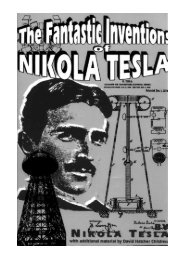the fantastic inventions of nikola tesla - Exopolitics Hong Kong
the fantastic inventions of nikola tesla - Exopolitics Hong Kong
the fantastic inventions of nikola tesla - Exopolitics Hong Kong
Create successful ePaper yourself
Turn your PDF publications into a flip-book with our unique Google optimized e-Paper software.
A different arrangement used in some <strong>of</strong> <strong>the</strong> bulbs constructed is illustrated in Fig. 23. In this instance a non-conductor<br />
m is mounted in a piece <strong>of</strong> common arc light carbon so as to project some small distance above <strong>the</strong> latter.<br />
The carbon piece is connected to <strong>the</strong> leading-in wire passing through a glass stem, which is wrapped with several<br />
layers <strong>of</strong> mica. An aluminium tube a is employed as usual for screening. It is so arranged that it reaches very nearly<br />
as high as <strong>the</strong> carbon and only <strong>the</strong> non-conductor m projects a little above it. The bombardment goes at first against<br />
<strong>the</strong> upper surface <strong>of</strong> carbon, <strong>the</strong> lower parts being protected by <strong>the</strong> aluminium tube. As soon, however, as <strong>the</strong> nonconductor<br />
m is heated it is rendered good conducting, and <strong>the</strong>n it becomes <strong>the</strong> centre <strong>of</strong> <strong>the</strong> bombardment, being<br />
most exposed to <strong>the</strong> same.<br />
I have also constructed during <strong>the</strong>se experiments many such single-wire bulbs with or without internal electrode, in<br />
which <strong>the</strong> radiant matter was projected against, or focused upon, <strong>the</strong> body to be rendered incandescent. Fig. 24<br />
illustrates one <strong>of</strong> <strong>the</strong> bulbs used. It consists <strong>of</strong> a spherical globe L, provided with a long neck n, on <strong>the</strong> top, for increasing<br />
<strong>the</strong> action in some cases by <strong>the</strong> application <strong>of</strong> an external conducting coating. The globe L is blown out on<br />
<strong>the</strong> bottom into a very small bulb b, which serves to hold it firmly in a socket S <strong>of</strong> insulating material into which it<br />
is cemented. A fine lamp filament /, supported on a wire w, passes through <strong>the</strong> centre <strong>of</strong> <strong>the</strong> globe L. The filament<br />
is rendered incandescent in <strong>the</strong> middle portion, where <strong>the</strong> bombardment proceeding from <strong>the</strong> lower inside surface<br />
<strong>of</strong> <strong>the</strong> globe is most intense. The lower portion <strong>of</strong> <strong>the</strong> globe, as far as <strong>the</strong> socket S reaches, is rendered conducting,<br />
ei<strong>the</strong>r by a tinfoil coating or o<strong>the</strong>rwise, and <strong>the</strong> external electrode is connected to a terminal <strong>of</strong> <strong>the</strong> coil.<br />
The arrangement diagrammatically indicated in Fig. 24 was found to be an inferior one when it was desired to render<br />
incandescent a filament or button supported in <strong>the</strong> centre <strong>of</strong> <strong>the</strong> globe, but it was convenient when <strong>the</strong> object<br />
was to excite phosphorescence.<br />
In many experiments in which bodies <strong>of</strong> a different kind were mounted in <strong>the</strong> bulb as, for instance, indicated in Fig.<br />
23, some observations <strong>of</strong> interest were made.<br />
It was found, among o<strong>the</strong>r things, that in such cases, no matter where <strong>the</strong> bombardment began, just as soon as a<br />
high temperature was reached <strong>the</strong>re was generally one <strong>of</strong> <strong>the</strong> bodies which seemed to take most <strong>of</strong> <strong>the</strong><br />
bombardment upon itself, <strong>the</strong> o<strong>the</strong>r, or o<strong>the</strong>rs, being <strong>the</strong>reby relieved. This quality appeared to depend principally<br />
on <strong>the</strong> point <strong>of</strong> fusion, and on <strong>the</strong> facility with which <strong>the</strong> body was •' evaporated," or, generally speaking,<br />
disintegrated—meaning by <strong>the</strong> latter term not only <strong>the</strong> throwing <strong>of</strong>f <strong>of</strong> atoms, but likewise <strong>of</strong> larger lumps. The<br />
observation made was in accordance with generally accepted notions. In a highly exhausted bulb electricity is<br />
carried <strong>of</strong>f from <strong>the</strong> electrode by independent carriers, which are partly <strong>the</strong> atoms, or molecules, <strong>of</strong> <strong>the</strong> residual<br />
atmosphere, and partly <strong>the</strong> atoms, molecules, or lumps thrown <strong>of</strong>f from <strong>the</strong> electrode. If <strong>the</strong> electrode is composed<br />
<strong>of</strong> bodies <strong>of</strong> different character, and if one <strong>of</strong> <strong>the</strong>se is more easily disintegrated than <strong>the</strong> o<strong>the</strong>rs, most <strong>of</strong> <strong>the</strong><br />
electricity supplied is carried <strong>of</strong>f from that body, which is <strong>the</strong>n brought to a higher temperature than <strong>the</strong> o<strong>the</strong>rs, and<br />
this <strong>the</strong> more, as upon an increase <strong>of</strong> <strong>the</strong> temperature <strong>the</strong> body is still more easily disintegrated.<br />
It seems to me quite probable that a similar process takes place in <strong>the</strong> bulb even with a homogeneous electrode, and<br />
I think it to be <strong>the</strong> principal cause <strong>of</strong> <strong>the</strong> disintegration. There is bound to be some irregularity, even if <strong>the</strong> surface is<br />
highly polished, which, <strong>of</strong> course, is impossible with most <strong>of</strong> <strong>the</strong> refractory bodies employed as electrodes. Assume<br />
that a point <strong>of</strong> <strong>the</strong> electrode gets hotter, instantly most <strong>of</strong> <strong>the</strong> discharge passes through that point, and a minute<br />
patch is probably fused and evaporated. It is now possible that in consequence <strong>of</strong> <strong>the</strong> violent disintegration <strong>the</strong> spot<br />
attacked sinks in temperature, or that a counter force is created, as in an arc; at any rate, <strong>the</strong> local tearing <strong>of</strong>f meets<br />
with <strong>the</strong> limitations incident to <strong>the</strong> experiment, whereupon <strong>the</strong> same process occurs on ano<strong>the</strong>r place. To <strong>the</strong> eye <strong>the</strong><br />
electrode appears uniformly brilliant, but <strong>the</strong>re axe upon it points constantly shifting and wandering around, <strong>of</strong> a<br />
temperature far above <strong>the</strong> mean, and this materially hastens <strong>the</strong> process <strong>of</strong> deterioration. That some such thing<br />
occurs, at least when <strong>the</strong> electrode is at a lower temperature, sufficient experimental evidence can be obtained in<br />
<strong>the</strong> following manner : Exhaust a bulb to a very high degree, so that with a fairly high potential <strong>the</strong> discharge<br />
cannot pass—that is, not a luminous one, for a weak invisible discharge occurs always, in all probability. Now raise<br />
slowly and carefully <strong>the</strong> potential, leaving <strong>the</strong> primary current on no more than for an instant. At a certain point,<br />
two, three, or half a dozen phosphorescent spots will appear on <strong>the</strong> globe. These places <strong>of</strong> <strong>the</strong> glass are evidently<br />
more violently bombarded than o<strong>the</strong>rs, this being due to <strong>the</strong> unevenly distributed electric density, necessitated, <strong>of</strong><br />
course, by sharp projections, or, generally speaking, irregularities <strong>of</strong> <strong>the</strong> electrode. But <strong>the</strong> luminous patches are<br />
constantly changing in position, which is especially well observable if one manages to produce very few, and this<br />
indicates that <strong>the</strong> configuration <strong>of</strong> <strong>the</strong> electrode is rapidly changing.<br />
From experiences <strong>of</strong> this kind I am led to infer that, in order to be most durable, <strong>the</strong> refractory button in <strong>the</strong> bulb<br />
should be in <strong>the</strong> form <strong>of</strong> a sphere with a highly polished surface. Such a small sphere could be manufactured from a<br />
diamond or some o<strong>the</strong>r crystal, but a better way would be to fuse, by <strong>the</strong> employment <strong>of</strong> extreme degrees <strong>of</strong>









